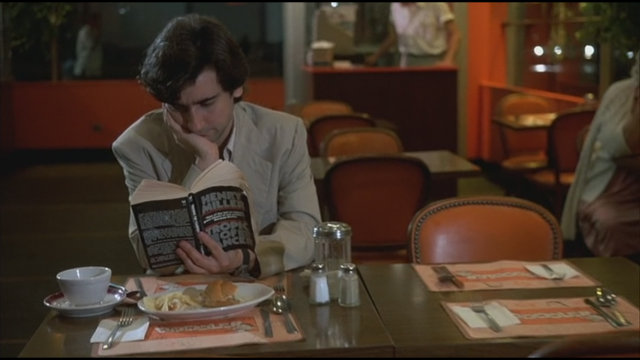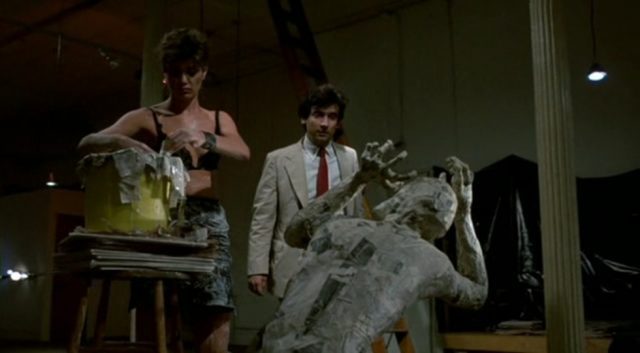
Paul Hackett’s (Griffin Dunne) nightmare starts innocently enough while reading Henry Miller’s TROPIC OF CANCER in a coffee shop in AFTER HOURS
AFTER HOURS (Martin Scorsese, 1985)
Film Society of Lincoln Center, Walter Reade Theater
165 West 65th St. at Amsterdam Ave.
Sunday, December 25, 6:00, and Monday, January 2, 9:15
Series runs through January 3
212-875-5601
www.filmlinc.org
 “We are all alone here and we are dead,” Henry Miller writes in the first paragraph of Tropic of Cancer, which is the book narcissistic word processor Paul Hackett (Griffin Dunne) is reading in a New York City coffee shop, catapulting him into a harrowing downtown nightmare in Martin Scorsese’s brilliant horror comedy, After Hours. Dunne, in one of his two best roles — the other was in John Landis’s very different horror comedy, 1981’s An American Werewolf in London — is exceptional as Hackett, a stand-in for the proverbial everyman seeking safety and home but bedeviled by circumstance, again and again and again. At the coffee shop, Hackett meets charming but unpredictable Marcy Franklin (Roseanna Arquette), who invites him over to her friend’s loft in SoHo. It’s already late, but the titillated Upper East Sider decides to takes a cab downtown; however, the last of his money, a twenty-dollar bill, literally flies out the window as his taxi driver (Larry Block) speeds like a madman through the mean streets of Manhattan. These eighties days predate ATMs, cashback, and Ubers, and Hackett spends the rest of his very long night encountering a bizarre cast of characters, none of whom seems able to give him the fifty-three cents he needs to cover the new subway fare of $1.50, which rose suddenly at midnight, plunging him into after-hours chaos. Among those he meets are kinky sculptor Kiki Bridges (Linda Fiorentino) and her sadist lover, Horst (Will Patton); lonely cocktail waitress and sixties leftover Julie (Teri Garr); helpful bartender Tom (John Heard); possible thieves Neil (Cheech Marin) and Pepe (Tommy Chong); ice-cream-truck driver Gail (Catherine O’Hara); and lonely lady June (Verna Bloom). Not the best judge of character, at least partly because he’s not exactly a sympathetic listener, the Yuppie-ish Hackett is soon running through the streets of SoHo in the rain, chased by an angry vigilante mob.
“We are all alone here and we are dead,” Henry Miller writes in the first paragraph of Tropic of Cancer, which is the book narcissistic word processor Paul Hackett (Griffin Dunne) is reading in a New York City coffee shop, catapulting him into a harrowing downtown nightmare in Martin Scorsese’s brilliant horror comedy, After Hours. Dunne, in one of his two best roles — the other was in John Landis’s very different horror comedy, 1981’s An American Werewolf in London — is exceptional as Hackett, a stand-in for the proverbial everyman seeking safety and home but bedeviled by circumstance, again and again and again. At the coffee shop, Hackett meets charming but unpredictable Marcy Franklin (Roseanna Arquette), who invites him over to her friend’s loft in SoHo. It’s already late, but the titillated Upper East Sider decides to takes a cab downtown; however, the last of his money, a twenty-dollar bill, literally flies out the window as his taxi driver (Larry Block) speeds like a madman through the mean streets of Manhattan. These eighties days predate ATMs, cashback, and Ubers, and Hackett spends the rest of his very long night encountering a bizarre cast of characters, none of whom seems able to give him the fifty-three cents he needs to cover the new subway fare of $1.50, which rose suddenly at midnight, plunging him into after-hours chaos. Among those he meets are kinky sculptor Kiki Bridges (Linda Fiorentino) and her sadist lover, Horst (Will Patton); lonely cocktail waitress and sixties leftover Julie (Teri Garr); helpful bartender Tom (John Heard); possible thieves Neil (Cheech Marin) and Pepe (Tommy Chong); ice-cream-truck driver Gail (Catherine O’Hara); and lonely lady June (Verna Bloom). Not the best judge of character, at least partly because he’s not exactly a sympathetic listener, the Yuppie-ish Hackett is soon running through the streets of SoHo in the rain, chased by an angry vigilante mob.

Paul Hackett (Griffin Dunne) has plenty to scream about after meeting sculptor Kiki Bridges (Linda Fiorentino) in Martin Scorsese’s brilliant black comedy
Written as a film-school project by Joseph Minion and inspired by Joe Frank’s monologue “Lies” (which led to a plagiarism battle), After Hours is shot in a modern noir style by regular Scorsese cinematographer Michael Ballhaus (Goodfellas, The Last Temptation of Christ, The Departed). Much of the film takes place in dark rooms and spaces; at one point, inside the S&M Berlin Club, Scorsese himself, in a cameo as a stage tech, shines a spotlight right into the camera, temporarily blinding the viewer. The many dichotomies in the film range from light and dark to uptown/downtown to fire and water; there are multiple references to fire and burns, as if Paul is trapped in a kind of hell, and it is often raining as he tries to find a way out. Paul’s metaphorical impotency is also a major theme; he keeps meeting women who are sexually attracted to him, but just as he can’t get north of SoHo, he has no luck in various bedrooms, for various reasons. In a bathroom, he sees a drawing of a shark chomping on an erect penis, and it’s no coincidence that Gail drives a Mr. Softee truck. The film also features cameos by character actors Clarence Felder as a bouncer, Dick Miller, Rocco Sisto, and Victor Argo as diner and coffee-shop employees, and Bronson Pinchot as Paul’s ambitious coworker, while the fab score ranges from Mozart and Bach to Joni Mitchell, the Monkees, Bad Brains, and Peggy Lee. A ferocious, fast-paced fantasia about abject loneliness, pretentious art, and the ever-present prospect of death, After Hours is screening December 25 and January 2 at the Walter Reade Theater as part of the Film Society of Lincoln Center series “Going Steadi: 40 Years of Steadicam,” which consists of twenty-nine films that feature the use of the Steadicam, invented by Garrett Brown and first used in 1976 in Hal Ashby’s Bound for Glory; the Steadicam operator for After Hours was one of the masters, Larry McConkey (Goodfellas, The Silence of the Lambs, Kill Bill). The series runs through January 3 and also includes Goodfellas, Quentin Tarantino’s Pulp Fiction and Jackie Brown, Stanley Kubrick’s Eyes Wide Shut and The Shining, Warren Beatty’s Bulworth, Bertrand Tavernier’s Coup de Torchon, Gus Van Sant’s Elephant, and Paul Thomas Anderson’s Boogie Nights and Magnolia.